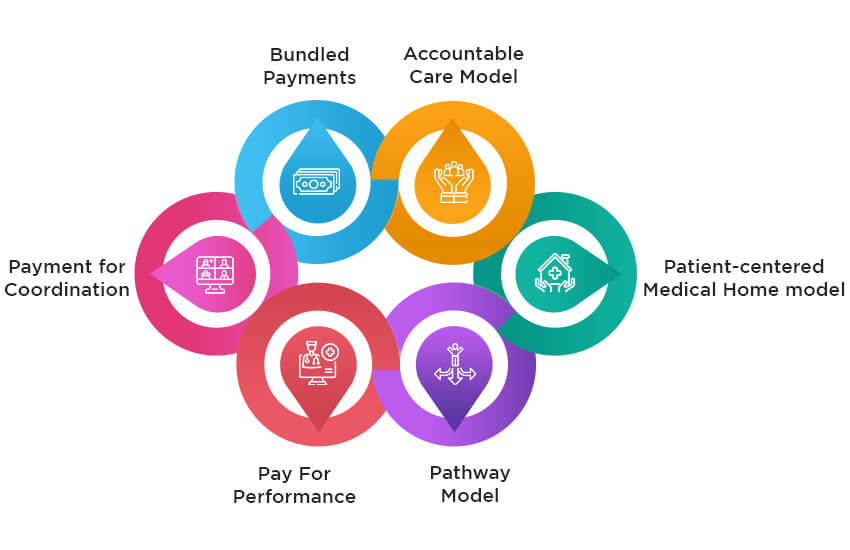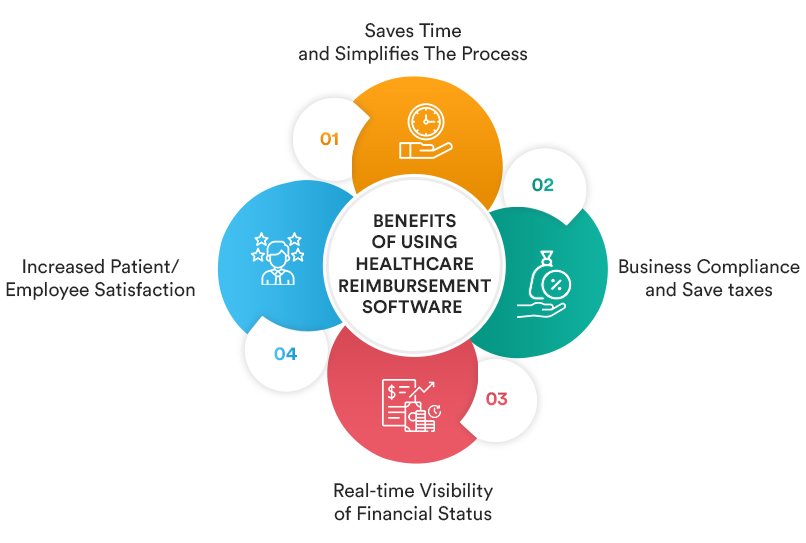Revenue Cycle Management in the U.S healthcare industry has been gaining momentum over the last few years. With the growing popularity mHealth and integrated healthcare systems, providers are concerned about payment delays and denials. The traditional payment and reimbursement system lacked efficiency and had frequent errors. But healthcare reimbursement solutions resolve most of these issues, helping providers with timely payment for their services.
The U.S healthcare reimbursement and payment systems have three key players- the government, employers/individuals, and private insurers. So, the payment for healthcare services comes from these three entities. And a compliant, integrated reimbursement payment system ensures seamless processing for faster payments and improved ROI. Moreover, customized healthcare reimbursement solutions benefit providers in many ways, as it’s developed as per practitioners’ needs.
Guide to Healthcare Reimbursement Solutions 2023
If you’re thinking of deploying quality healthcare reimbursement systems, here are some crucial aspects to consider for better outcomes.
- Medical Coding- Without accurate coding, it’s difficult to define the type of care service delivered and results in payment delays or denials. So, providers must ensure that treatment codes and billing chores are authentic and 100% correct. Providers can use healthcare automation or clinical informatics solutions to leverage the coding tasks.
- Coverage- After coding, the healthcare providers must check with the claim coverage part. Although insurers take care of the coverage part as per the care services and available benefits, providers must recheck for minimum errors.
- Payment- Once the coding and coverage part is clear, insurers can release the payment. However, insurers can employ healthcare analytics solutions to identify the payments and their mode.
Difference between FFS and VBR
The current healthcare reimbursement industry is experiencing a paradigm shift from Fee For Service to Value-Based Reimbursement models. Most of the healthcare providers solutions focused on value-based care, where patients are consumers. And their experience determines the payment part to a certain extent.
Healthcare reimbursement vendors and insurers are interestingly willing to adopt value-based reimbursements. So, if you’re also trying to shift from FFS to VBR models, you must understand the fundamental differences.
Fee- For-Service is the most common model of reimbursements in the healthcare system. This model bases the payment amount on the cost of products, services, or technologies that physicians order. Medical billing professionals include products and services with their prices listed to inform insurers or patients; whosoever are paying. Since these products and services listed in the medical bill are as per doctors or providers, often patients are left unsatisfied with products and services. This impacts the patient experience, which disrupts patient engagement systems too. Moreover, the billing professionals deploy medical records management solutions or clinical data analytics to understand the patients’ diagnoses accurately.
Additionally, the fee-for-service model of healthcare reimbursement charges for every single service provided. This includes consultations, tests, scans, and so on. Needless to point out, this incentivizes physicians to sometimes provide too many services, some of which might be redundant or unnecessary. Experts point out that this is one of the biggest reasons for the excessive healthcare spending in the United States. Moreover, the fee-for-service type of health care reimbursement does not consider the clinical outcomes for the patients.
On the contrary, value-based reimbursement is a pay-for-performance model. VBR model is gaining popularity among many providers. Healthcare organizations find this model to reduce costs and enhance the quality of care. The government also promotes this model under the type ACA so that Medicare and Medicaid programs continue to offer maximum benefits.
The value-based model of medical reimbursement considers the outcomes of the patients. In other words, it does not view the number of services provided but the treatment progress. So, the value-based reimbursement model incentivizes providers to focus on the quality of their services instead of quantity.
Here are some types of VBR models.
Models of Value-based Reimbursement System

The rapidly growing care costs in the United States have resulted in calls to change healthcare reimbursement systems. The spending on healthcare reached $4 trillion, more than the economies of all but four countries. Payers and policymakers have devised multiple models of value-based healthcare reimbursement to control the growing cost. Let’s look at some of them
Bundled Payments: Value-based care aims to ensure the best quality of care. In the VBR model, too, quality care and reduced costs are the goals. So, bundled payments model is a type of value-based reimbursement model. Bundled payments model simplifies the bill into one collective care episode. This means that the patient, employer, or insurer pays a single amount instead of paying different providers throughout the care episode. Further, the payment received gets divided among the different providers involved in that care episode. The only downside of this model is the risk of loss. However, this model is also effective in ensuring the best quality care. Further, the providers can minimize risks in this model by leveraging custom healthcare solutions.
Accountable care model– Accountable care model is the most preferential model of the value-based reimbursement model. ACOs ensure that patients receive the best care whenever required at the most affordable costs. Healthcare providers in ACOs deal with checks and accountability to keep the process accurate and smooth. Moreover, ACOs require excellent coordination through communications and accountability. So, it’s essential to ensure smooth and secure electronic data exchange and medical records management. Also, providers must pay special attention to their electronic health records too. This will reduce errors and loss of payments.
Patient-centered Medical Home model– Quite similar to ACO is the patient-centered reimbursement model. Although this model follows similar goals of providing the best quality care, it’s different from ACO, as the PCMH model is a method employed by a single provider. It offers personalized care to patients through 5 attributes. These are patient-centeredness, quality/safety, comprehensive services, accessibility, and care coordination. Providers employing PCMH must employ different tools like integrated care management to improve these attributes. Integrated care will ensure more safety and coordinated care. Moreover, this model is quite suitable for home health reimbursement.
Pathway model– Healthcare reimbursement at times differs as per health disciplines. The Pathway model is an evidence-based decision-making tool that serves oncologists and patients to choose the best and most affordable care treatment.
Pay For Performance: As the name indicates, this healthcare reimbursement model bases its payments on the physicians’ performance. It compensates them for meeting certain quality, efficiency, and results criteria. This model can be especially helpful for people suffering from long-term illnesses who need frequent clinical visits. This kind of healthcare reimbursement has been adopted by both Medicare as well as private insurance payers.
Payment for Coordination: The payment for coordination model of healthcare reimbursement is good for certain providers. It reimburses for specified care coordination services, such as home care. This kind of health care reimbursement will pay the provider organization, like a home care services company, to deliver care coordination services. This is so because such care services are typically not reimbursed by regular health plans.
Benefits of Using Healthcare Reimbursement Software
Healthcare reimbursement solutions are either of these models. However, the benefits these offers are comprehensive and similar. If you’re confused about deploying healthcare reimbursement solutions, then here are some benefits of healthcare payment reimbursement solutions.

Saves time and simplifies the process– Traditional method of patient billing reimbursements takes time and is a complicated process. Deploying healthcare reimbursement systems will reduce the time and complexities of the process. This speeds up the process, and providers get their payments faster. Insurers are also benefitted as it reduces their work burden by simplifying the workflow.
Business compliance and Save taxes– In the case of reimbursing employees for their health insurance, the healthcare reimbursement software offers tax-saving benefits to employers or organizations. This makes the business compliant in saving tax, IRS, and Federal compliance. Besides, the businesses are also compliant with ACA, which has some new requirements for healthcare reimbursement solutions. So, the developers need to ensure HIPAA compliance with the healthcare reimbursement solutions.
Real-time visibility of financial status– Health insurance billing and reimbursement helps providers with real-time financial status information. With meaningful financial information, the healthcare providers can plan and make necessary investment decisions for growth.
Increased patient/employee satisfaction– Healthcare reimbursement solutions streamline the workflow of this medical billing and payment process. It reduces time and costs of reimbursement but ensures quality care. Mainly value-based reimbursement models aim to provide the best quality patient care that eventually increases patient satisfaction.
Can Data Analytics Drive Better Healthcare Reimbursement Solutions?

The healthcare industry has been implementing digital technologies across all of its operations. Healthcare software is everywhere, whether scheduling appointments, managing hospitals, running practices, or inventorying and tracking finances. Such software is bound to generate data about many aspects of day-to-day operations. Analyzing that data can reveal important insights to help healthcare organizations optimize their operations and boost productivity.
One of the main aspects of everyday operations at healthcare organizations is revenue cycle management (RCM). Health insurance reimbursement is the main source of revenue for providers, and all the workflows around RCM are centered on it. In light of this, it is only sensible to have reliable healthcare reimbursement solutions to streamline day-to-day activities. Data generated from operations provides insights about reimbursements, enabling management to make informed decisions.
Analyzing the type and nature of healthcare reimbursement from numerous patients reveals patterns. These include health plans, coverage, denials, rejections, time taken for full payment, explanation of benefits (EOB), etc. The data from these parameters helps providers and healthcare administrators to identify the problem areas in the workflows. These might include the payers who deny most often, the kind of services covered by what health plans, reasons for denials and rejections, time taken by payers for reimbursements, and so forth.
The patterns and the insights they provide help providers and payers work together for better cooperation. Subsequently, the corresponding healthcare reimbursement systems can also work with greater efficiency. Healthcare reimbursement solutions with analytics modules incorporated into them can access the relevant data securely and process the same to reveal many actionable insights. This will be especially helpful for large hospitals to know the nature of the revenue cycle management operations better and streamline healthcare reimbursement.
Data analytics is becoming a major driving force within the broader software sector. Experts concur that most companies in almost every industry will leverage analytics to optimize their operations and drive profit. Healthcare is no different, and since medical reimbursement makes up the bulk of the revenues, it is only sensible that the industry leverage data analytics for its revenue operations. Assessing data provides the edge when maximizing returns on investment in healthcare reimbursement solutions. To sum it up, it is safe to say that data-driven assessment of reimbursements will power the next generation of software for health insurance billing and reimbursement.
The Role Of Artificial Intelligence On The Future Of Healthcare Reimbursement Solutions

Artificial intelligence is the hottest buzzword in the software industry. Simply put, artificial intelligence (AI) is the simulation of human intelligence by computing systems. They work with datasets to automate software operations.
Medical billing reimbursement solutions often need patients’ data for functioning. They are integrated with hospital information systems and electronic health records for seamless interoperability. The staff working at healthcare organizations would need to carry out manual workflows to enter the necessary data and complete the activities related to claims submission and payment processing. But clinical data analytics and artificial intelligence-based healthcare reimbursement solutions can eliminate or minimize the need for human intervention. They would maximize the speed, productivity, and efficiency of all workflows surrounding healthcare payment.
With the introduction of IoT-powered wearable devices, the amount of health data generated is growing rapidly. Moreover, the types of data have increased in number. In light of this, the type of medical services and the methods of their subsequent reimbursements are bound to evolve over the next few years. This need has prompted providers, payers, and policymakers to address healthcare inequities since they might only widen if left unchecked.
An additional advantage of artificial intelligence-driven healthcare reimbursement solutions is the cost of care. Since AI would reduce the overhead, it is expected that the administrative and operational bureaucracy involved in healthcare reimbursement and payment systems. With growing calls for a more value-based approach to reimbursements, the need for newer healthcare billing solutions has never been greater. Artificial intelligence, alongside data analytics, can help break new ground on medical reimbursements and make the future of healthcare brighter.
Conclusion
Healthcare reimbursement solutions are changing the view of medical billing and coding, and payments. Even though the FFS and VBR models are both effective, the VBR model ensures better practice management. It’s due to timely payments, patient-centeredness, and coordinated care. However, it’s also essential for medical billers and coders, and insurers to consider potential challenges like lack of training, documentation errors, and more. So, healthcare reimbursement solutions are an excellent help for providers and insurance companies in today’s revenue cycle management.
OSP is a trusted software development company that delivers bespoke solutions as per your business needs. Connect with us to hire the best talents in the industry to build enterprise-grade software.

How can we help?
Fill out the short form below or call us at (888) 846-5382
Looking for software solutions to build your product?
Let's discuss your software solutions for your product in our free development acceleration call!
Get In Touch arrow_forwardDiscuss Your Project Handover with a team of expert Book a free consultation arrow_forward
About Author

Written by Riken Shah linkedin
Riken's work motto is to help healthcare providers use technological advancements to make healthcare easily accessible to all stakeholders, from providers to patients. Under his leadership and guidance, OSP Labs has successfully developed over 600 customized software solutions for 200+ healthcare clients across continents.

















